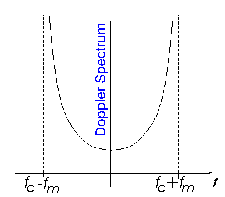
 |
www.WirelessCommunication.NLChapter: Wireless Channels
|

The Doppler shift of this wave is
![]() ,
,
where v is the speed of the antenna.
The maximum Doppler shift occurs for a wave coming from the
opposite direction as the direction the antenna is moving to. It has a shift
v
f_m = -- f_c
c
with f_c is the carrier frequency and c the velocity of light.
Such motion of the antenna leads to (time varying) phase shifts of individual reflected waves. It is not so much this minor shift that bothers us in mobile reception, as a receiver can easily compensate for it. Rather, it is the fact that many waves arrive, all with different shifts. Thus, their relative phases change all the time, and so it affects the amplitude of the resulting composite signal. So the Doppler effects determine the rate at which the amplitude of the resulting composite signal changes.
This leads to the U-shaped power spectrum for isotropic scattering,
1 1
S(f) = -------- -------------------------
4 pi f_m (f-f_c)^2
sqrt( 1 - -----------)
f_m^2
where we assumed a unity local mean power.

Figure: Power density spectrum of a sine wave suffering from a Doppler spread.
If a sinusoidal signal is transmitted (represented by a spectral line in the frequency domain), after transmission over a fading channel, we will receive a power spectrum that is spread according to the above image. The frequency range where the power spectrum is nonzero defines the Doppler spread.




